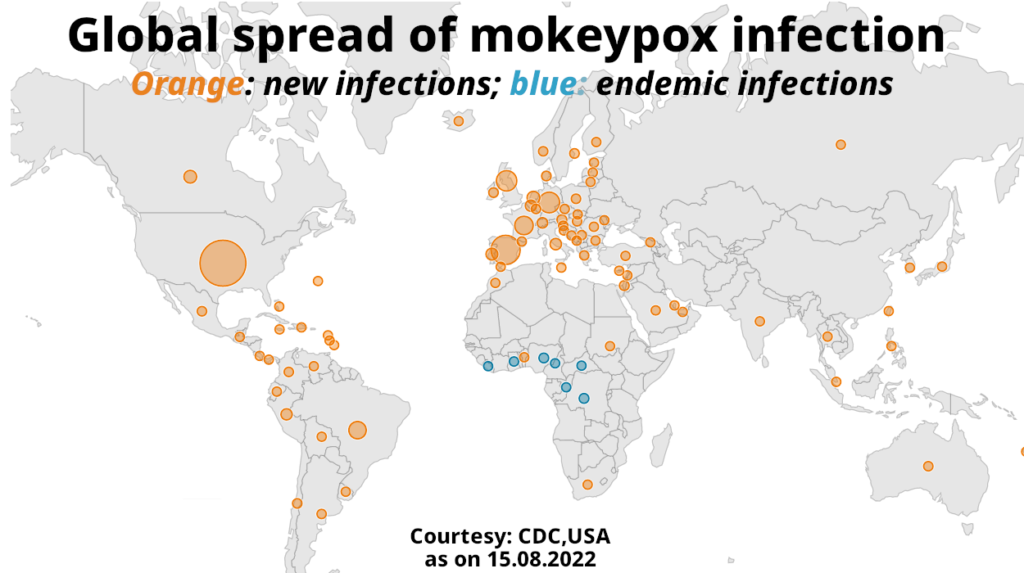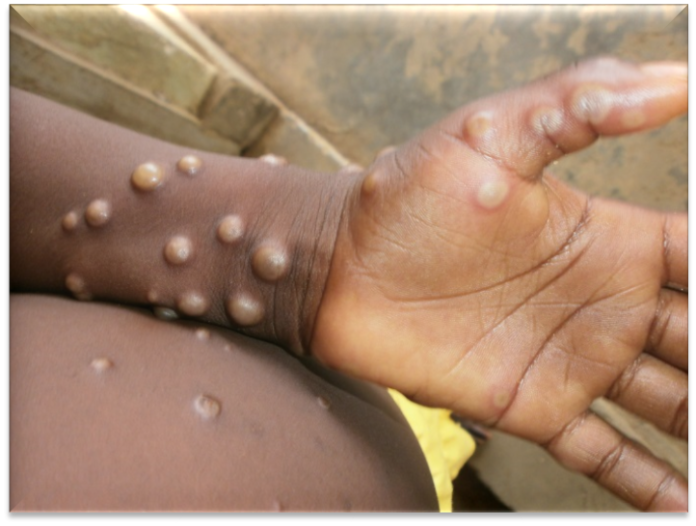Manoj Pandey*
On 23rd July, just two months after the first cases of monkeypox were observed in Europe, the World Health Organisation declared this disease as a public health emergency of international concern. This is WHO’s way of saying that it is a very serious disease that can spread globally, and cause serious health emergencies in different parts of the world.
As if to prove the WHO right, by the middle of August, the disease has been detected in 92 countries as compared to about ten African countries two months back where it was endemic and not wide-spread. Around 39,000 people have been reported infected globally. The way the graph of this ‘rare’ disease is rising, it is going to be a serious health concern.
Some similarities between monkeypox and COVID 19 make one worried. For example, COVID 19 and monkeypox both have first spread fast beyond their places of origin, in Europe. COVID 19 too was initially taken lightly, even by the WHO. Both are viral diseases and have spread fast, and across many countries, after they were first noticed.
Is monkeypox going to be the next COVID 19?
Let me give you bare facts so that you can make an informed inference about that.
What is monkeypox and how does it spread?
- Monkeypox is a viral disease (like COVID 19), caused by a DNA virus of the pox family. Biologically, it is related to smallpox, a highly infectious and fatal disease that has been eradicated, but not to chickenpox. Luckily, monkeypox is much less fatal and infectious than smallpox.
- Monkeypox disease was detected for the first time in lab monkeys and so got its name. But it is supposed to be more prevalent among wild rats and squirrels. Like COVID 19 virus, it is capable of switching from animals to humans. It is believed that the virus has regularly been jumping from animals to humans in the African region.
- Monkeypox is endemic to some countries in Central and West Africa. Only in 2022 has it been found to have spread widely to other areas, starting with Europe and Central Asia.
- Unlike the COVID 19 virus, monkeypox virus is not an unknown virus, and it does not spread fast through many ways. That means, the world is much better prepared to fight it even if it explodes to an epidemic level.
- This virus has variants, but just a couple. The virus is likely to mutate much slower than the COVID 19 virus. That gives the hope that vaccines will be much easier to make and more stable than those for COVID 19.
- The disease spreads mainly through contact, and to some extent through nasal secretions. Contact includes not only direct contact with the infected person, but also using the same clothes and other objects.
- Though majority of cases have been found among men who had multiple sexual relations with men, it is not a sexually transmitted disease. It can infect anyone that comes in contact with the infected person or contaminated objects. The contact can be as innocuous as using the hotel room that was occupied by an infected person before you.
- The infected person can infect others from the time of first symptoms, or even before, and continues to do so till the last scabs have fallen and new skin has formed.
- The symptoms of monkeypox include rashes on different parts of the body, often more prominent on and around genitals. They look like pimples or blisters, and can be itchy and painful. These pustules develop scabs before healing. Fever and body ache are common, and flu-like symptoms also occur in some people.
- The first symptoms usually show up in 1-3 weeks from infection and the symptoms last for 2-4 weeks.
What are the treatments available?
As I said earlier, monkeypox is much less lethal than smallpox and COVID 19, and so far, only 12 deaths have been reported. This comes to about 3 deaths among 10,000 infected persons.
There is no specific treatment for monkeypox and, in majority of cases, the disease goes away on its own. In most cases, symptomatic treatments against fever, itching, etc are followed. In more pronounced and severe cases, antiviral drugs are administered.
Since monkeypox was, so far, an endemic disease (that too in poor countries), no specific drugs and vaccines are available against it. The WHO has now started coordinating research and drug-discovery.
For vulnerable people (those likely to be in contact with infected persons and those with weak immunity), vaccines already available for similar viruses are being recommended as of now. In the USA, JYNNEOS vaccine and TPOXX antiviral drug have been recommended by the country’s top health authority (Center for Disease Control and Prevention).
So, monkeypox is not likely to become a pandemic like COVID 19?
As of now, monkeypox is being called a ‘multi-country outbreak’, which is much lower in infectious disease classification than ‘epidemic’ and ‘pandemic’.

Though the infection has been traced in more than a third of all the countries in the world, within a few months, there are reasons why it may not be as big a concern as COVID 19, even dengue and malaria.
Look at the following facts:
- The factoids given above show that monkeypox is much less severe in major parameters – how fast it spreads, how severe it is, and how lethal it can be – as compared to COVID 19.
- Monkeypox is not widespread in communities. Though it has been found to have reached most continents, the number of people affected by it is very small in most countries. Within countries too, it has not spread to different regions except in some European countries and the USA.
- The disease is not spreading through ‘community transmission’, that is, spreading wantonly among many people without getting traced to the source.
- Even in regions where it has spread fast, it has been possible to check its spread to manageable levels.
However, monkeypox is not to be taken lightly. There are serious concerns regarding its impact on society. Look at the major ones:
- There is a risk of the disease spreading through mice and rats, which can catch the disease from humans and then spread it back to humans. Being present everywhere and roaming around houses, hospitals, gutters and municipal waste-bins, these can be potential carriers of the disease everywhere.
- At least one case of a pet catching the disease from his masters has been reported. The risk from such transmission to-and-from pets is not known, but could be high.
- Since monkeypox has remained endemic to only a small part of the world, there is no in-built immunity in the rest of the population against this virus. On the other hand, many scientists believe that the virus has been in circulation in societies, for months if not years, before the European outbreak. If so, the virus might already be there in big numbers, waiting to mutate to a highly virulent mutant. However, as of now, this does not point towards a devastating scenario.
- Though as of now, monkeypox virus does not have many strains, new strains might arise if the disease spreads in large communities. There is a risk that some of the new strains will be more infectious and fatal. Already, a Central African strain has been found to be highly lethal.
- Since majority of monkeypox cases have been reported from people with a certain sex-orientation that has no wide acceptance in the society, a stigma gets attached to such a disease. That can make people hide the disease and thus become silent carriers.
- There is no vaccine available against monkeypox. The vaccines being recommended are not specifically meant for this virus, and their efficacy is doubtful. Breakthrough cases against the existing vaccines (cases in which people get infection after being vaccinated) have been found in the US.
Epidemiologists say, since the world has become so much connected through large-scale travel, major outbreaks of infectious diseases in many parts of the world cannot be ruled out in future. However, monkeypox – going by the nature of the pathogen as well as the alertness in the health systems – is not likely to turn pandemic. At least, not as horrible as COVID 19.
Monkeypox in India
If you are not uptodate on the situation of monkeypox infection in India, let me give you some titbits.
India comes in ‘moderate-risk’ category, indicating that it needs to be prepared against its fast spread. Central and State Governments seem to be adequately alert and responsive.
So far, ten cases of monkeypox, and one death from it, have been reported. A couple of more cases suspected to be of monkeypox infection are under observation. These have been reported from Kerala, Delhi, Uttar Pradesh, Bihar and Telangana.
The first case was reported in mid-July in Kerala – a person who was in contact with an infected person in the UAE. A locally-transmitted case, without a travel history, has also been found.
Going by the genealogy of Indian strains, it appears that the virus has been circulating in the society for some time. One more factor to be considered is that a large population is already vaccinated against smallpox, that might provide enough protection (herd immunity!) against monkeypox.
Further reading
- Guidelines for Management of Monkeypox Disease
- Is monkeypox a pandemic? Experts explain why it’s not another COVID-19
- Monkeypox
- WHO Director-General’s statement…

Manoj Pandey is a former civil servant. He does not like to call himself a rationalist, but insists on scrutiny of apparent myths as well as what are supposed to be immutable scientific facts. He maintains a personal blog, Th_ink
Disclaimer: The views expressed in this article are the personal opinion of the author and do not reflect the views of raagdelhi.com which does not assume any responsibility for the same.



